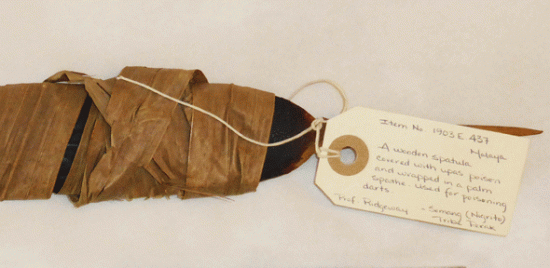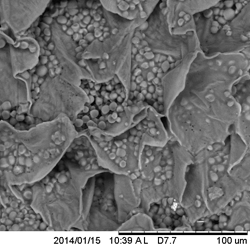University of Cambridge
Source - http://www.cam.ac.uk/research/features/poisons-plants-and-palaeolithic-hunters?

Dozens of common plants are toxic. Archaeologists have long suspected that our Palaeolithic ancestors used plant poisons to make their hunting weapons more lethal. Now Dr Valentina Borgia has teamed up with a forensic chemist to develop a technique for detecting residues of deadly substances on archaeological objects.

Aconitum napellus, credit Wikimedia Commons
We’re surrounded by poisonous plants: they thrive in our parks and gardens, hedgerows and woodlands. Foxgloves (Digitalis) look charming but their seeds can kill. The flowers of monkshood (Aconitum napellus) are a stunning blue but its roots can be deadly. Hemlock (Conium maculatum) is both common and extremely toxic as Shakespeare reminds us in Macbeth with the incantations of the witches. Archaeologists have long believed that our ancestors used poisons extracted from such plants to make their weapons more lethal and kill their prey more swiftly. By dipping an arrow head into a poisonous paste, the hunter could ensure that an animal would receive a dose of toxic chemicals - alkaloids or cardenolides - that would either kill it immediately or slow it down. Until very recently it has been impossible to prove that poisons extracted from plants were used by early societies. Now Dr Valentina Borgia, a specialist in Palaeolithic hunting weapons and Marie Curie Fellow at the McDonald Institute for Archaeological Research, believes that she is on the brink of being able to prove that our ancestors used poisons as far back as 30,000 years ago. Borgia has approached the likely use of poisons by our distant ancestors from a number of viewpoints. Her research looks at the ubiquity of poisonous plants in many local environments and their use both historically and by modern hunter-gatherers. Working with a forensic chemist she has also developed techniques capable of detecting tiny residues of poison on archaeological objects. She is now putting those techniques to the test with samples obtained from museum collections.

Starches of Aconite
“We know that the Babylonians, Greeks and Romans used plant-based poisons both for hunting animals and in war. In fact, the word ‘toxic’ come from toxon, the Greek for bow. Taxus is a genus of the yew tree with a springy timber traditionally used to make bows. It also produces seeds used to poison arrows. In Britain, yews grown for their timber were planted in churchyards so that animals wouldn’t be poisoned by eating their berries,” says Borgia. “Few hunter-gatherer societies remain today but all the groups that have survived employ poisons. The Yanomami people of the Amazonian rainforest use curare - a mix of Strychnos genus plants - to poison their arrows. In Africa, a variety of different plants are used to make poisons. Acokanthera, Strophantus and Strychnos are the most common.” Many Northern Asian populations used monkshood (Aconitum) to kill large animals such as bear and Siberian ibex. Poisonous plants also feature in folklore. In Malaysia, darts are poisoned using Antiaris toxicaria, a poison that comes from the Upas tree. A Malaysian legend says: “Seven up, eight down and nine no life”. The victim takes seven steps uphill, eight steps downhill and a ninth final step. In 2014, Borgia enlisted the expertise of forensic chemist Michelle Carlin (Northumbria University) to help her devise a method for identifying residues of poison. Carlin’s day-to-day work is focused on crime and the detection of illegal substances through chemical analysis. Using a highly specialist technique called liquid chromatography-mass spectrometry, she is able to detect invisible traces of drugs – such as cocaine in pocket linings.

Pot of Aconitum wrapped in the 1926 newspaper, copyright of Museum of Archaeology and Anthropology, Cambridge;
The same technique can be used to detect the presence of poisons used thousands of years ago. Together Borgia and Carlin have created a database listing toxic plants and have developed a non-destructive method of collecting samples of residues from archaeological materials, by simply touching the item with cotton imbued with pure water. Samples of poisonous plants were supplied to the researchers by the Botanic Garden at the University of Cambridge and Alnwick Castle in Northumberland. Alnwick has a Poison Garden where visitors can see 150 poisonous plants. Some (such as monkshood) are so toxic that Alnwick has to obtain a licence from the Home Office in order to cultivate them. Another route to identification of plant residues is to look for the presence of starches which remain on the surface of the prehistoric weapons. Starch grains can be used to determine plant taxa: each species has distinctive size, shape and structure. Borgia has collaborated with a major expert in this methodology, Dr Huw Barton (University of Leicester) in order to use starching testing as one of her research tools. Many museums with ethnographical collections have poisoned weapons in their displays and stores. Borgia has been able to collect samples from objects held by the Museum of Archaeology and Anthropology in Cambridge, the Pitts Rivers Museum in Oxford and the Museo Etnografico Pigorini of Roma (Italy) with the collaboration of her Italian colleague, Dr Jacopo Crezzini. The objects include a Chinese pot with Aconite poison inside (wrapped in a newspaper dated 13 July 1926), Malaysian darts poisoned with Upas, various African arrows and a glass tube containing curare. “The wonderful craftsmanship used to create objects so strongly associated with poison is also significant. As the French philosopher Simondon says, there is no pure technical device free from symbolic meaning,” says Borgia. “These artefacts fully express this concept, as they show a high degree of care. A scary-looking Borneo harpoon, wonderfully carved, in the Cambridge museum is thought to have been made from a human bone. A card, conserved with it, warns ‘Care. Has been poisoned’.” Carlin’s analysis of these samples of materials has shown that residues of poisons are easily detectable on the objects a century later and that the residues retained their chemical characteristics. Now the real challenge for the researchers is to go much further back in time.
PART.2